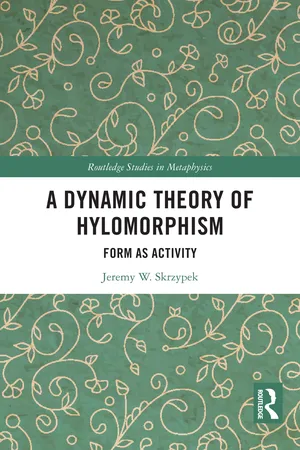
- English
- ePUB (mobile friendly)
- Available on iOS & Android
About this book
This book introduces a novel hylomorphic theory of material objects, according to which material objects are understood as comprised or composed of both matter and activity, where activity plays the role of form. This theory, "hyloenergeism, " captures the dynamic nature of many of the objects of our experience, such as living organisms, better than other leading varieties of contemporary hylomorphism.
Hylomorphism is the theory according to which material objects are understood as comprised or composed of two fundamental parts, components, aspects, or principles: matter and form. Many contemporary hylomorphists endorse a version according to which the form of a material object is understood as a certain kind of complex relation or structure realized in its material parts. Others endorse a version according to which the form of a material object is understood as a certain kind of power or disposition continuously activated in the object or in its material parts. This book argues against structural and dispositional varieties of hylomorphism in favor of a third approach: hyloenergeism. Drawing on various aspects of traditional Aristotelian hylomorphism and other contemporary occurrence-based theories of material objects, it argues that hyloenergeism has the resources to successfully avoid or resolve several major concerns for other competing hylomorphic views.
A Dynamic Theory of Hylomorphism will appeal to researchers and graduate students working in metaphysics, ancient philosophy, and medieval philosophy.
Frequently asked questions
- Essential is ideal for learners and professionals who enjoy exploring a wide range of subjects. Access the Essential Library with 800,000+ trusted titles and best-sellers across business, personal growth, and the humanities. Includes unlimited reading time and Standard Read Aloud voice.
- Complete: Perfect for advanced learners and researchers needing full, unrestricted access. Unlock 1.4M+ books across hundreds of subjects, including academic and specialized titles. The Complete Plan also includes advanced features like Premium Read Aloud and Research Assistant.
Please note we cannot support devices running on iOS 13 and Android 7 or earlier. Learn more about using the app.
Information
Table of contents
- Cover
- Half-Title
- Series
- Title
- Copyright
- Contents
- Acknowledgements
- Introduction
- 1 Form as Structure: Structural Hylomorphism
- 2 Three Concerns for Structural Hylomorphism
- 3 Form as Power: Dispositional Hylomorphism
- 4 Activity, Process, and Object: Some Contemporary Resources
- 5 Form as Activity: Hyloenergeism
- 6 The Virtues of Hyloenergeism
- 7 Conclusion
- Bibliography
- Index